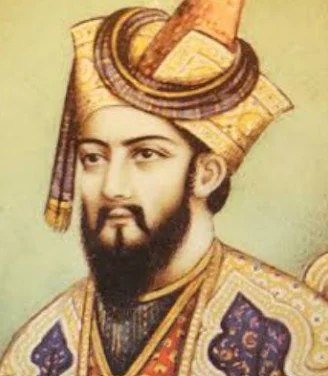Introduction
Babur, descendant of Timur and Chengiz Khan, rose in Fergana, Uzbekistan, aspiring for Samarkand. Finding refuge in India, he conquered Punjab, uniting Kabul and Qandhar with Northern India, laying the groundwork for a centralized empire and enhancing trade. In his brief reign from 1526 to 1530 AD, he left a lasting impact on the subcontinent.
Legacy of Babur: Conquests, Warfare, and Cultural Contributions in India
1. Babur’s Path to Conquest and Consolidation
- Ancestral Lineage: Babur’s distinguished ancestry traces its roots to Turko-Mongol conquerors:
- Timur through his paternal lineage, and Mongol ruler Chengiz Khan through his maternal lineage.
- Strategic Shift: Babur succeeded his father in ruling the small principality of Fergana (a city in Uzbekistan) and inherited his ambition to conquer Samarkand.

-
- Challenges: However, the financial strain and potential Uzbek threat led Babur to consider India as a refuge and a strategic base for further operations.
- Babur’s Claim to Afghan Territories: When Babur conquered Afghanistan, he believed he had a rightful claim to these territories (like Punjab) as they were annexed by Babur’s ancestor, Timur.
- Political Instability in India: The unstable political scenario in India and discontent among Afghans and Rajputs against Ibrahim Lodi facilitated his conquest.
- Support from Regional Powers: He initially received support from rulers like Daulat Khan Lodi and Rana Sanga for his invasion.
- Reuniting Kabul and Qandhar: Babur reunited Kabul and Qandhar with Northern India after defeating the Lodis and the Rajput Confederacy.
- Strategic Security and Centralization: It provided strategic security for the first time after the downfall of the Kushan Empire thus paving the way for a centralised empire in India.
- Economic Implications: This unification facilitated foreign trade, integrating India with trans-Asian trade networks.
2. Major Conquests in India
- First Battle of Panipat (1526): was fought between Babur and Ibrahim Lodi.
- Babur had conquered Delhi and Agra with an agenda to subdue the Rajputs and Afghans to solidify his rule.
- Battle of Khanwa (1527): Fought between forces of Babur on one side and Rana Sanga along with Mahmud Lodi (brother of Ibrahim Lodi) and Hasan Khan Mewati (ruler of Mewat) on the other.
- He later took the title of Ghazi after this war.
- Battle of Chanderi (1528): Led to Babur’s victory over Medini Rai of Chanderi in Malwa.
- Battle of Ghagra (1529): Babur’s final battle was against the Afghans. He fought against the combined forces of Mahmud Lodi and Nusrat Shah(Bengal) along the banks of the Ghagra.
- However, Babur died in 1530 during his journey from Agra to Lahore.
3. Military and Warfare:
- Gunpowder Advancements: Although gunpowder was known in India earlier, Babur exemplified its skilled use with artillery and cavalry. [UPSC 2015]
- Tulguma System: Babur introduced a new warfare method known as the Tulguma system in the first battle of Panipat.
- Tulughma meant dividing the whole army into various units.
- Horses as a Strategic Asset: The Mughals in control of the Khyber Pass got a consistent supply of high-quality horses from the West which enhanced their military capabilities.
| Cannons were an important addition in sixteenth-century warfare. Babur used them effectively in the first battle of Panipat. |
4. Art and Architecture
-
- Architectural Legacy: Introduced Char Bagh (Persian-style garden layout); Constructed mosques in Panipat and Sambhal.
- Literature: Babar was proficient in Persian and Arabic.
-
- Tuzuk-i-Baburi(Baburanamah): His autobiography, Provides an insight into his military strategies.
- Written in Turkish, his mother tongue.
- Reflects the fondness that Babur had for Indian land.
- Legacy of Memoir Writing: With his fervour for detailed writing, Babur established a tradition of keeping memoirs, a practice that was followed by his successors in India.
- Religious Views: Despite being an orthodox Sunni, Babur maintained an open-minded approach.
-
- He was devoted to the Naqshbandiyya Sufi Khwaja Ubaidullah Ahrar.
Conclusion
Babur’s conquests in India, including victories at Panipat, Khanwa, and Chanderi, marked a significant chapter in history. His military innovations, like the Tulguma system and effective use of cannons, reshaped warfare. Through his autobiography and architectural legacies like the Char Bagh, Babur left a lasting imprint on India’s culture and history, shaping its future for generations.
![]() May 14, 2024
May 14, 2024
![]() 5954
5954
![]() 0
0
